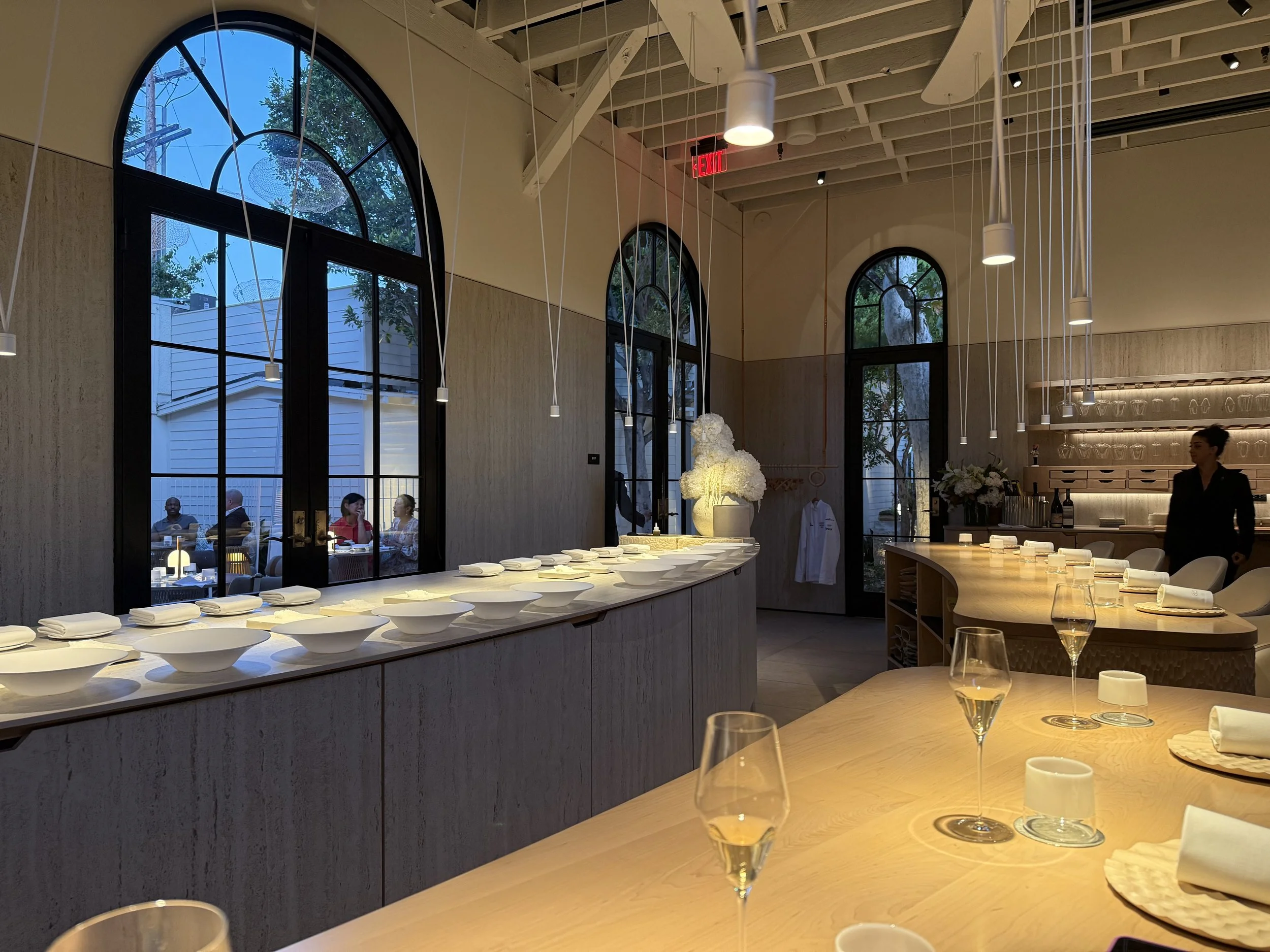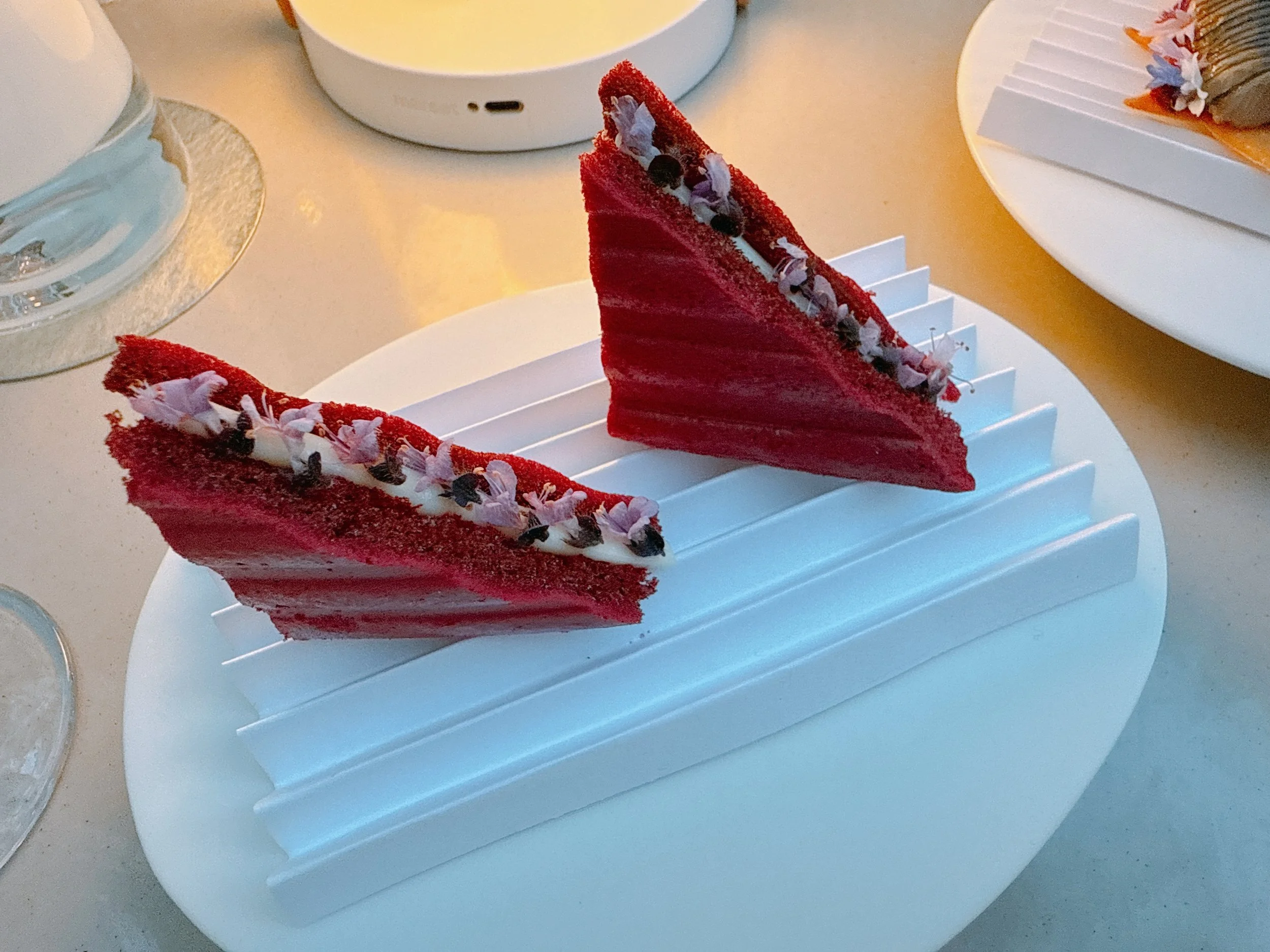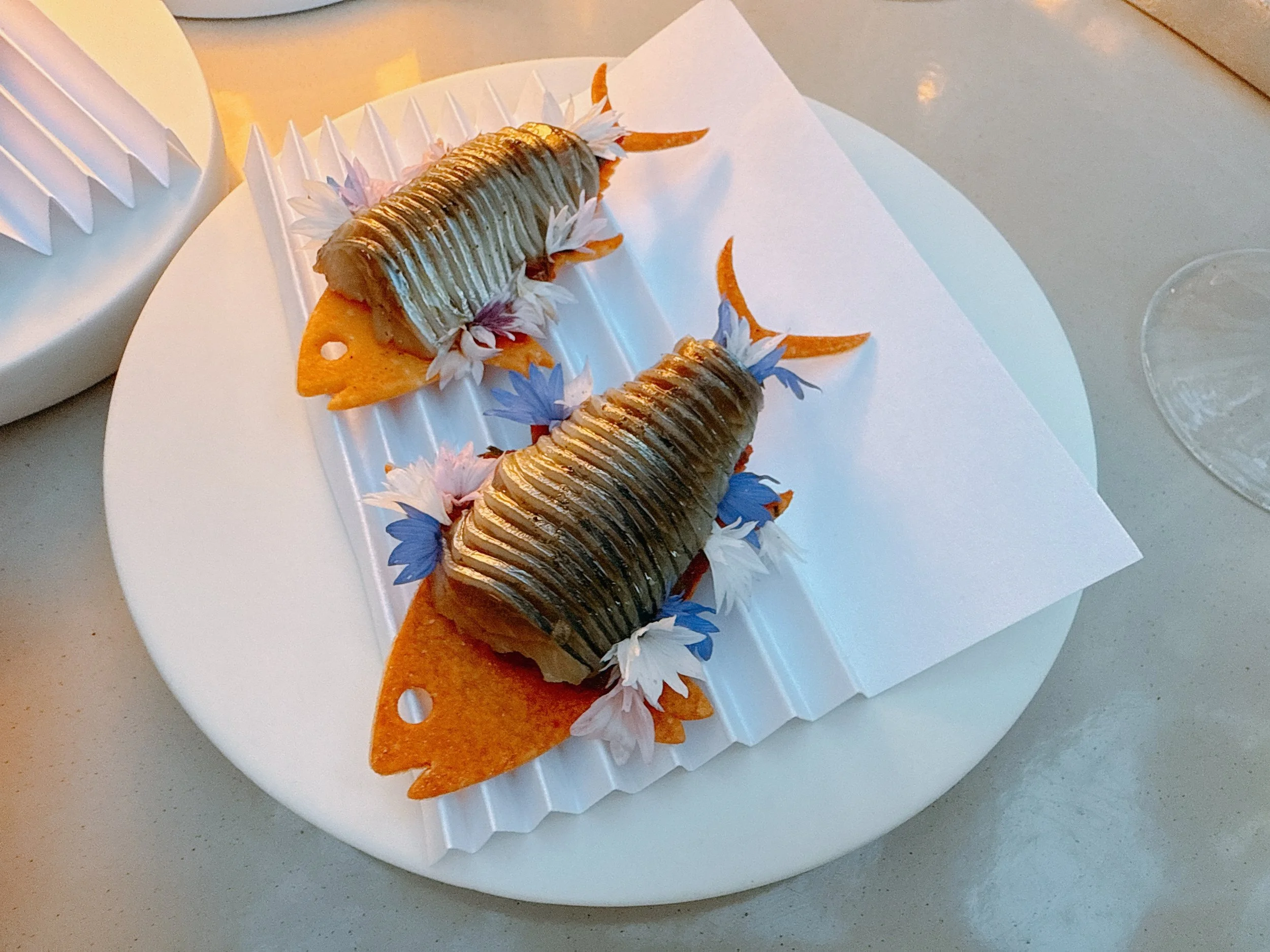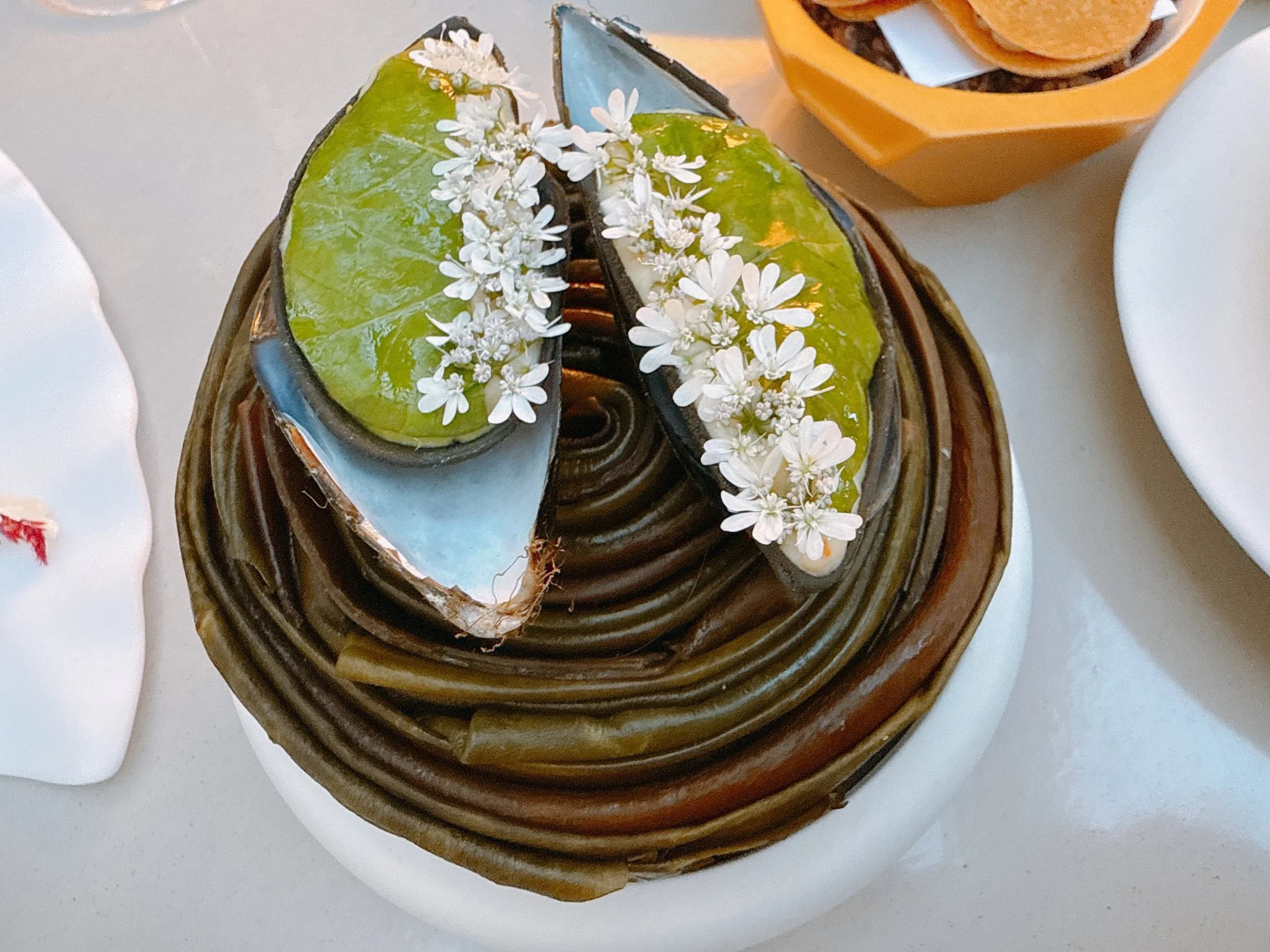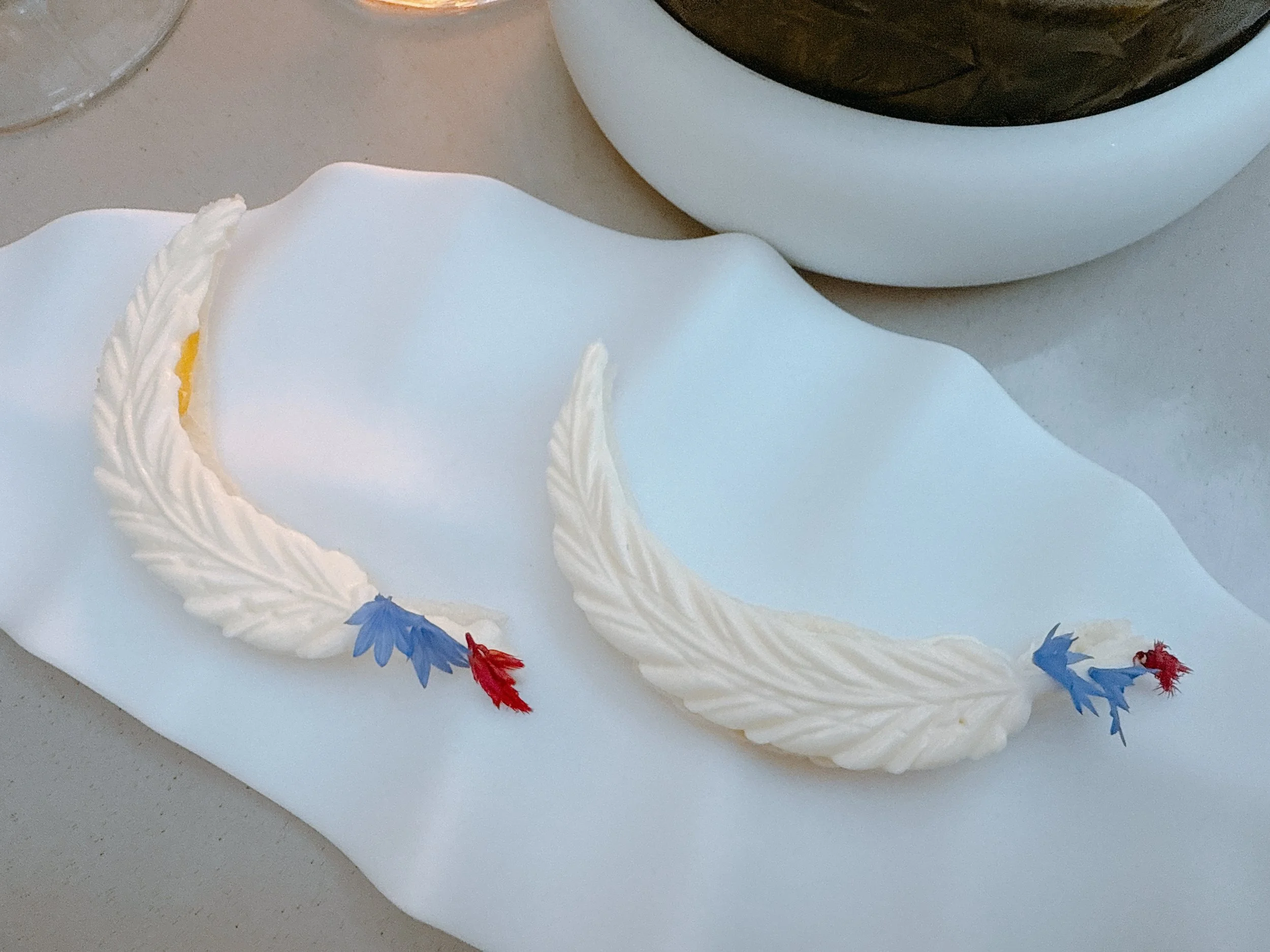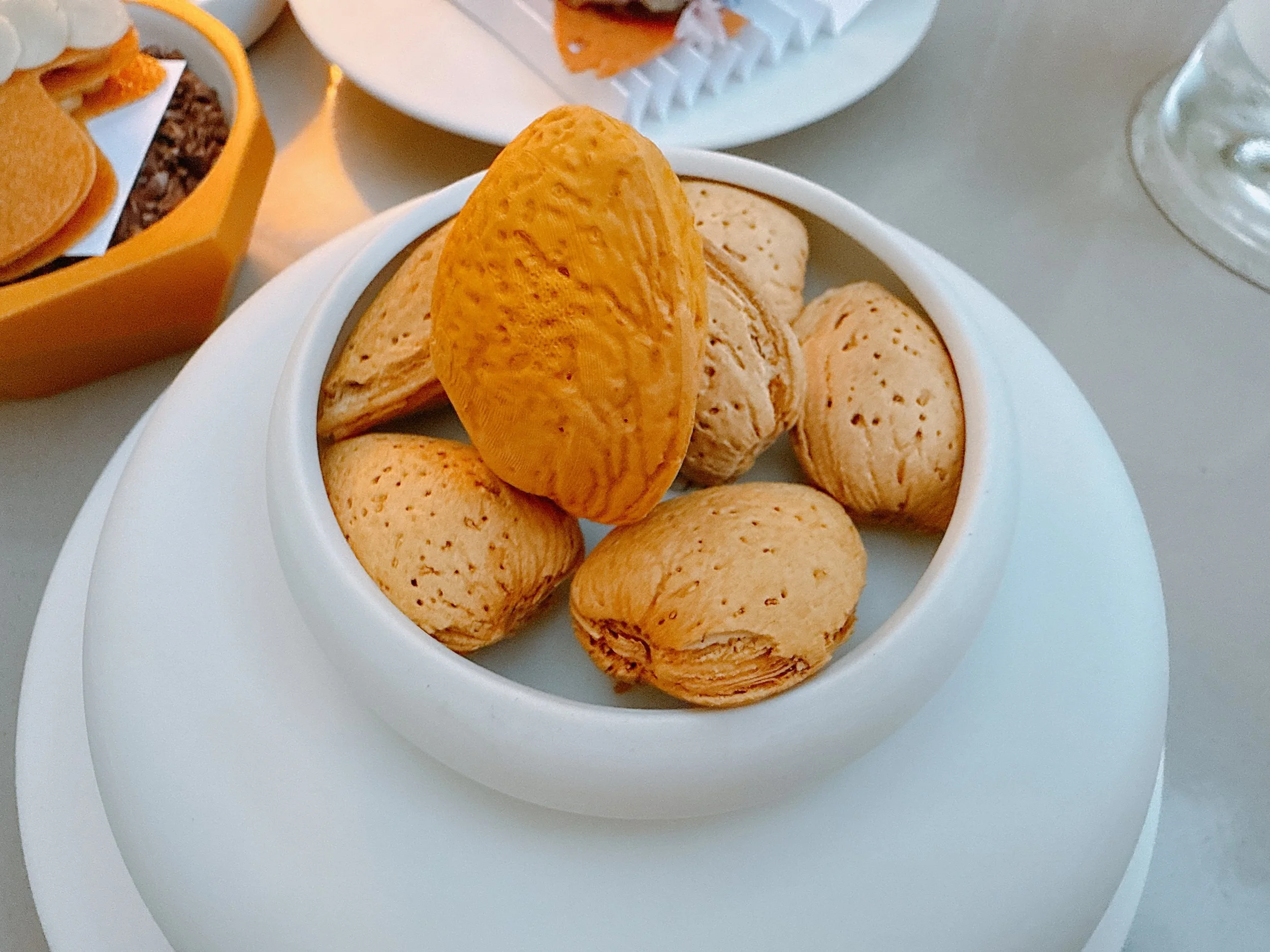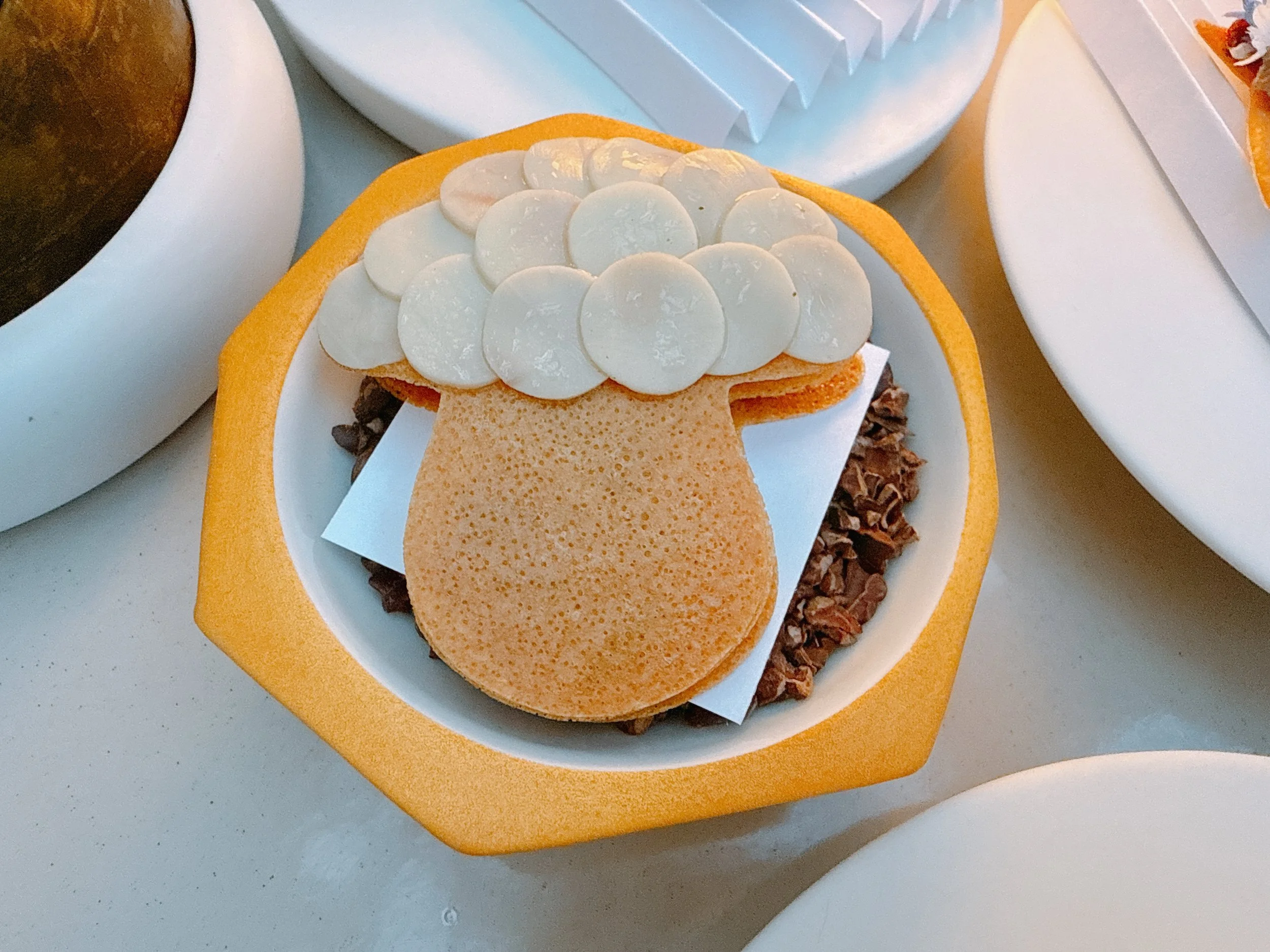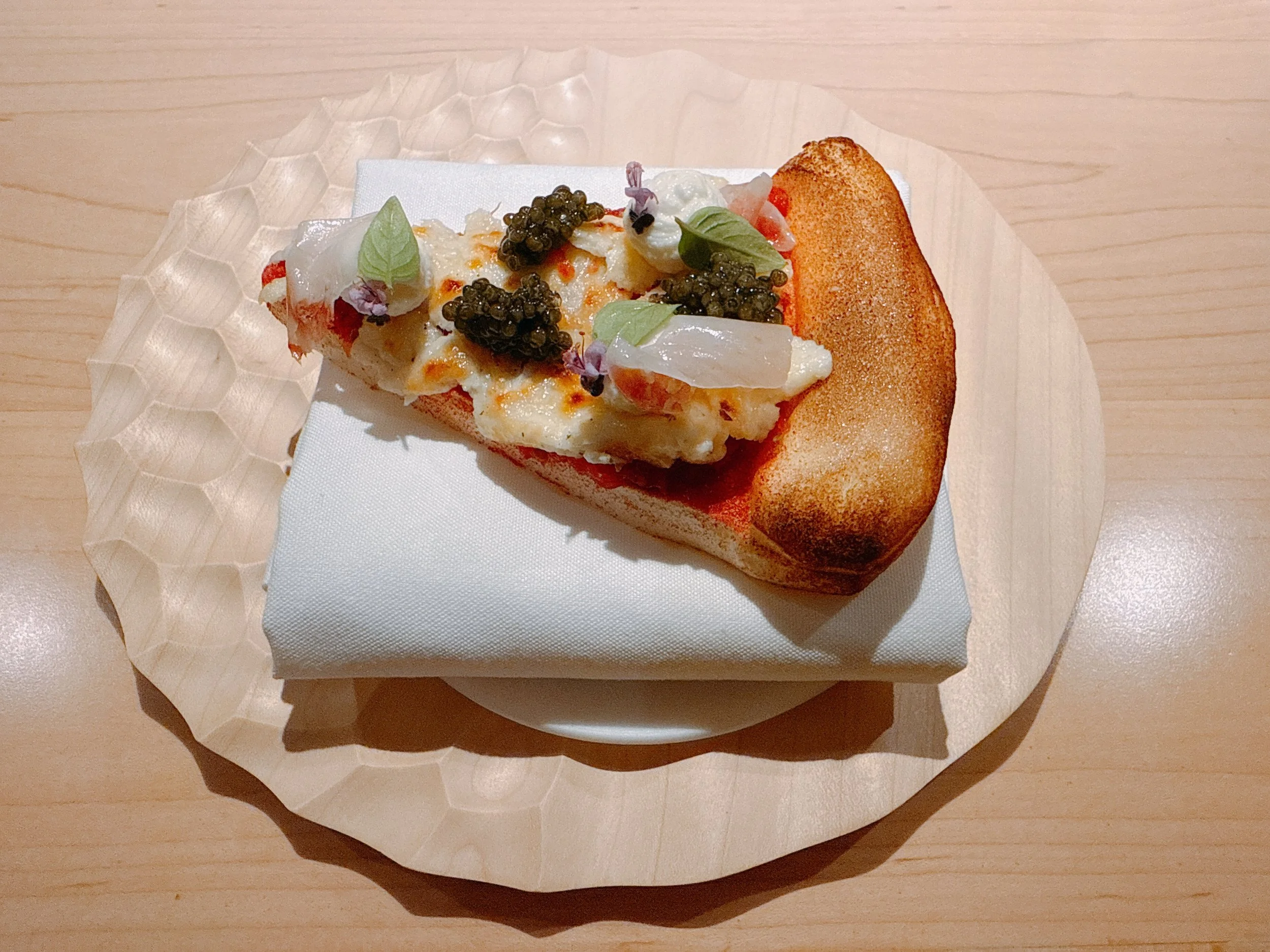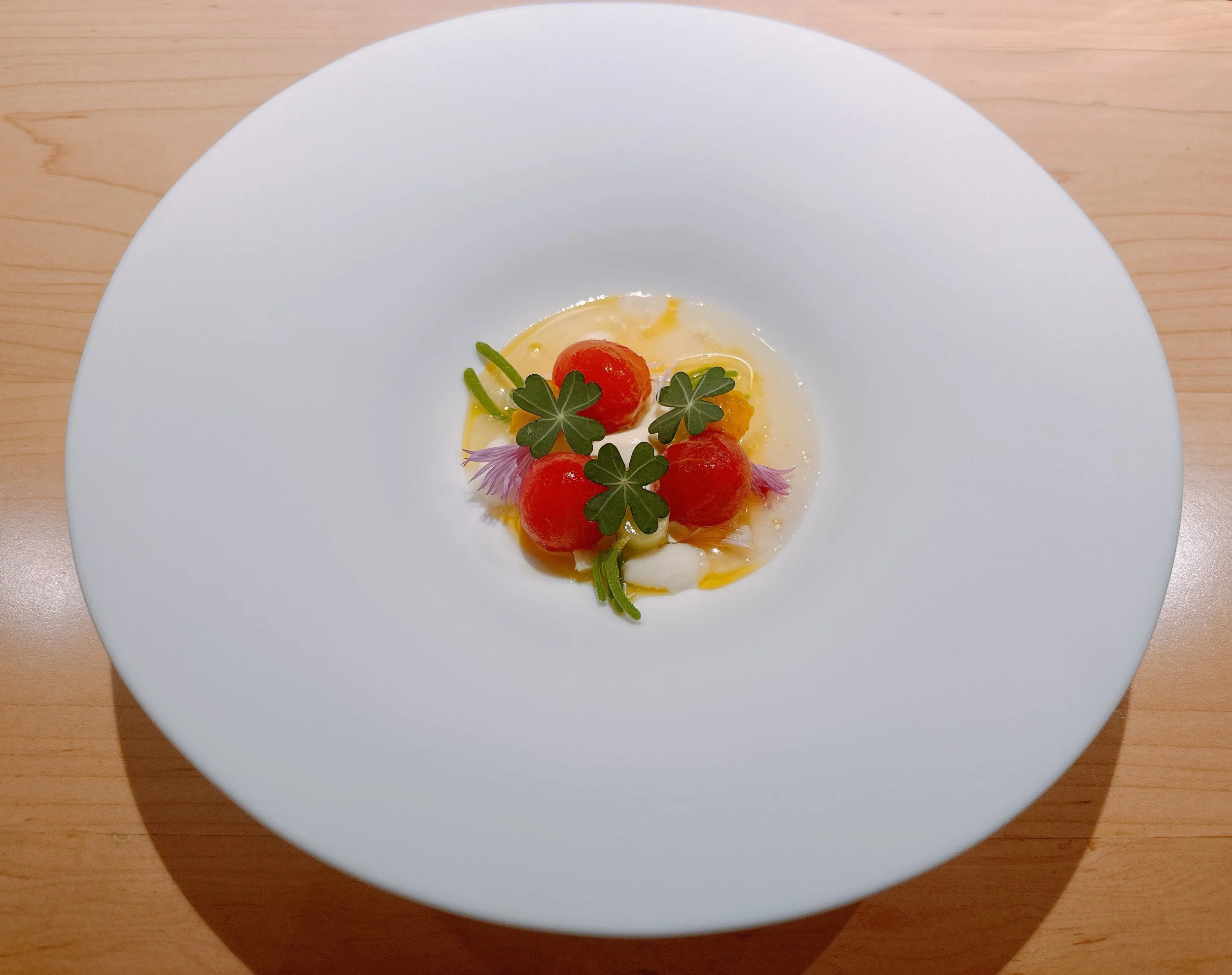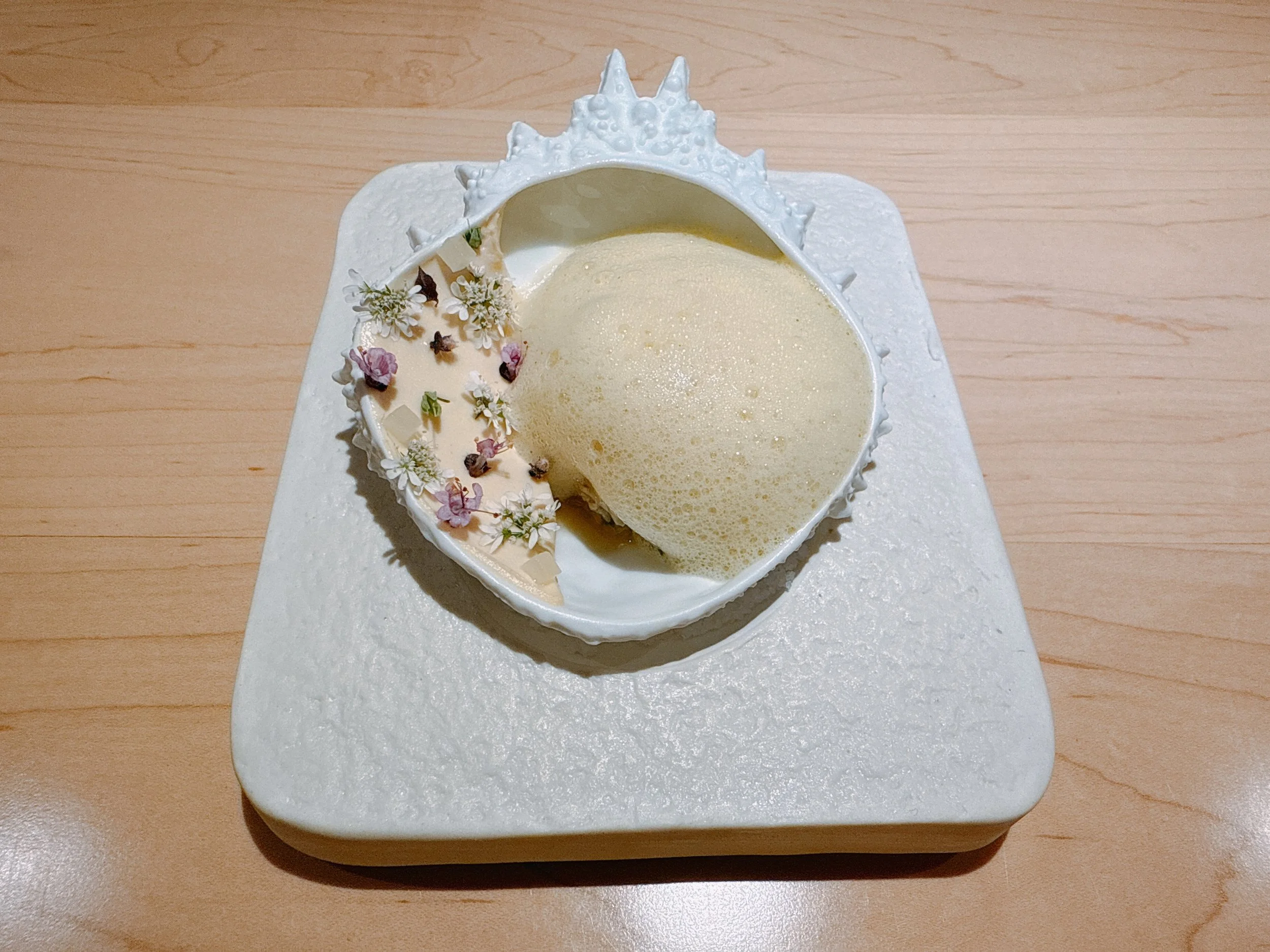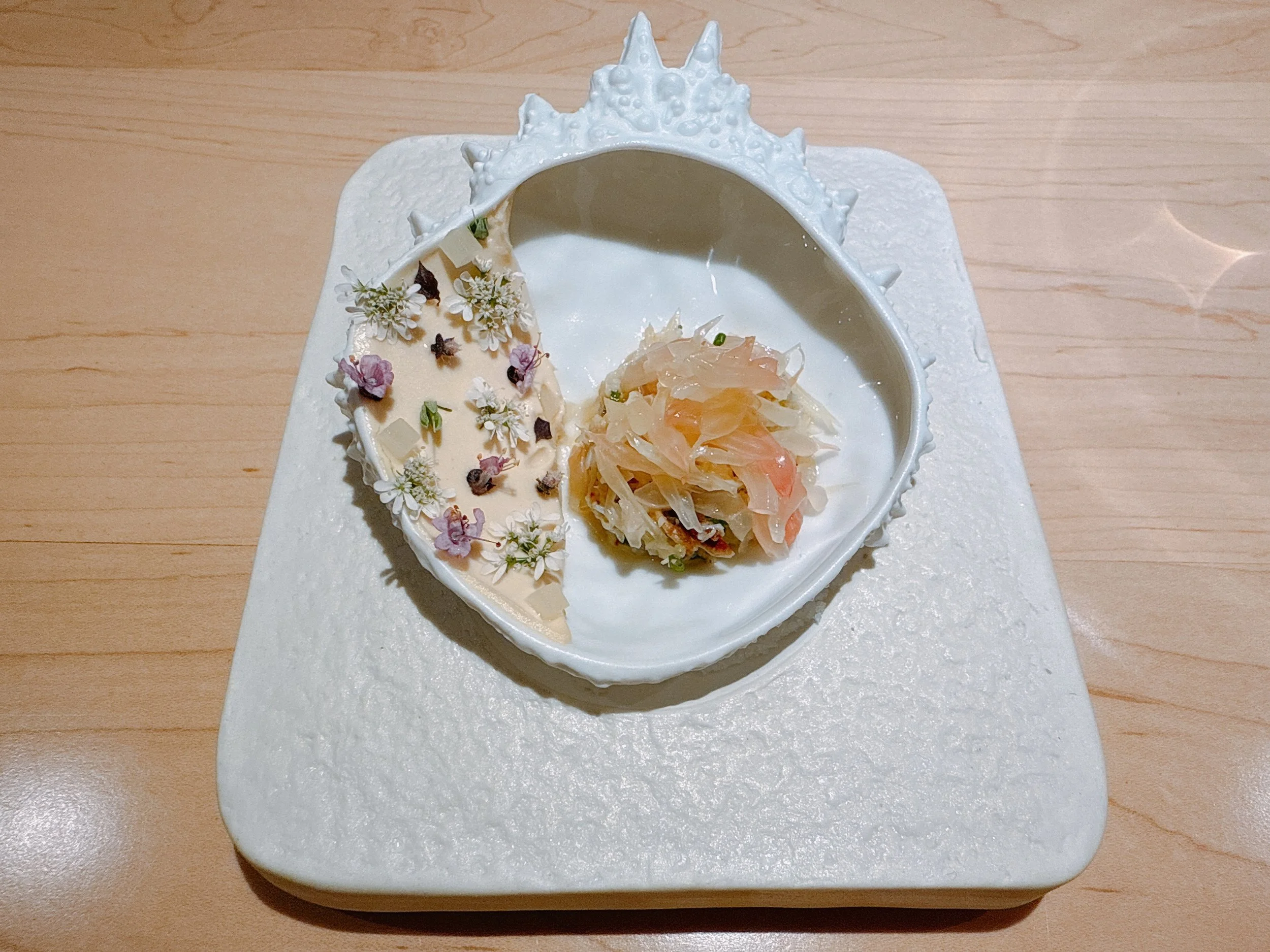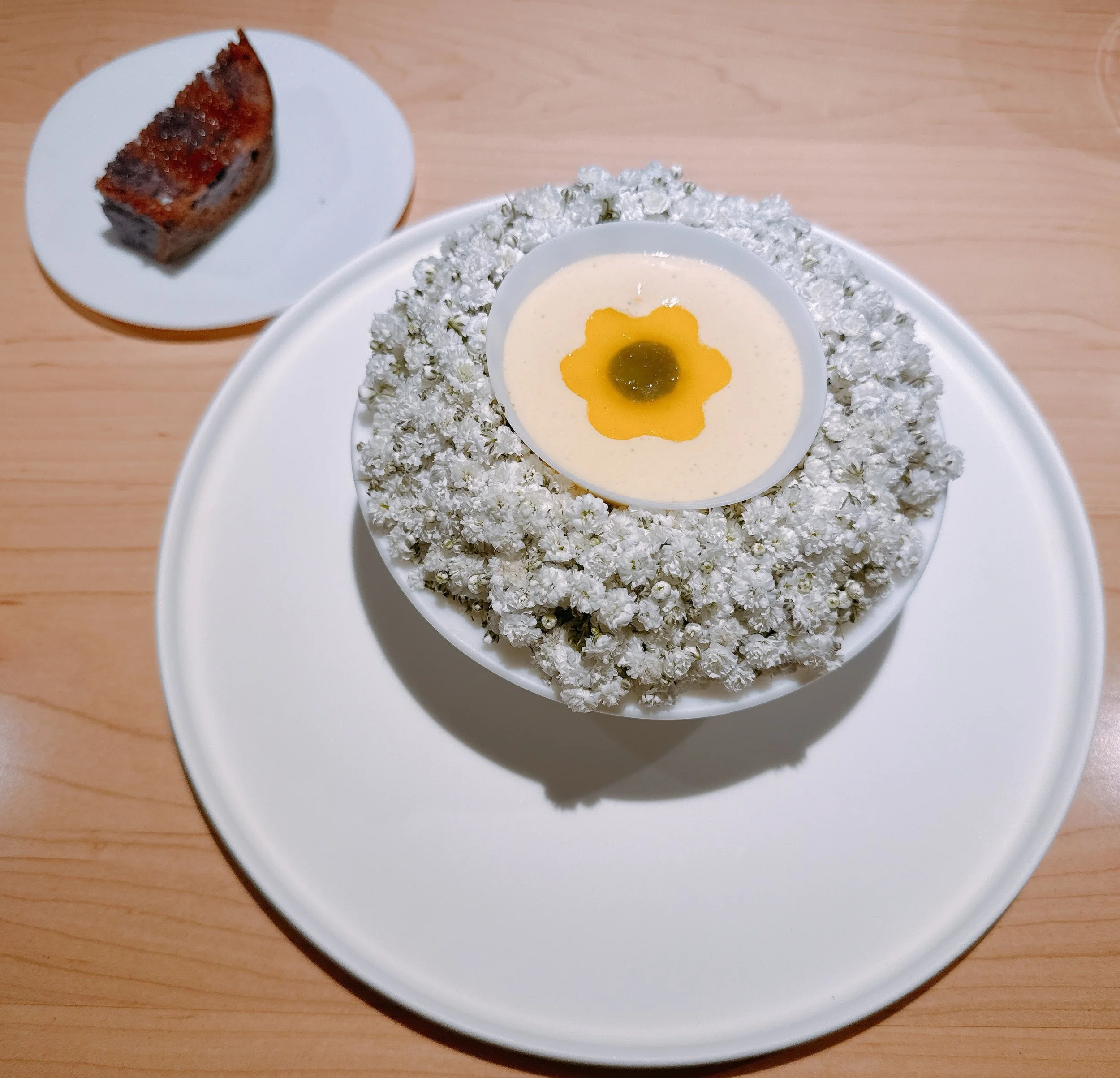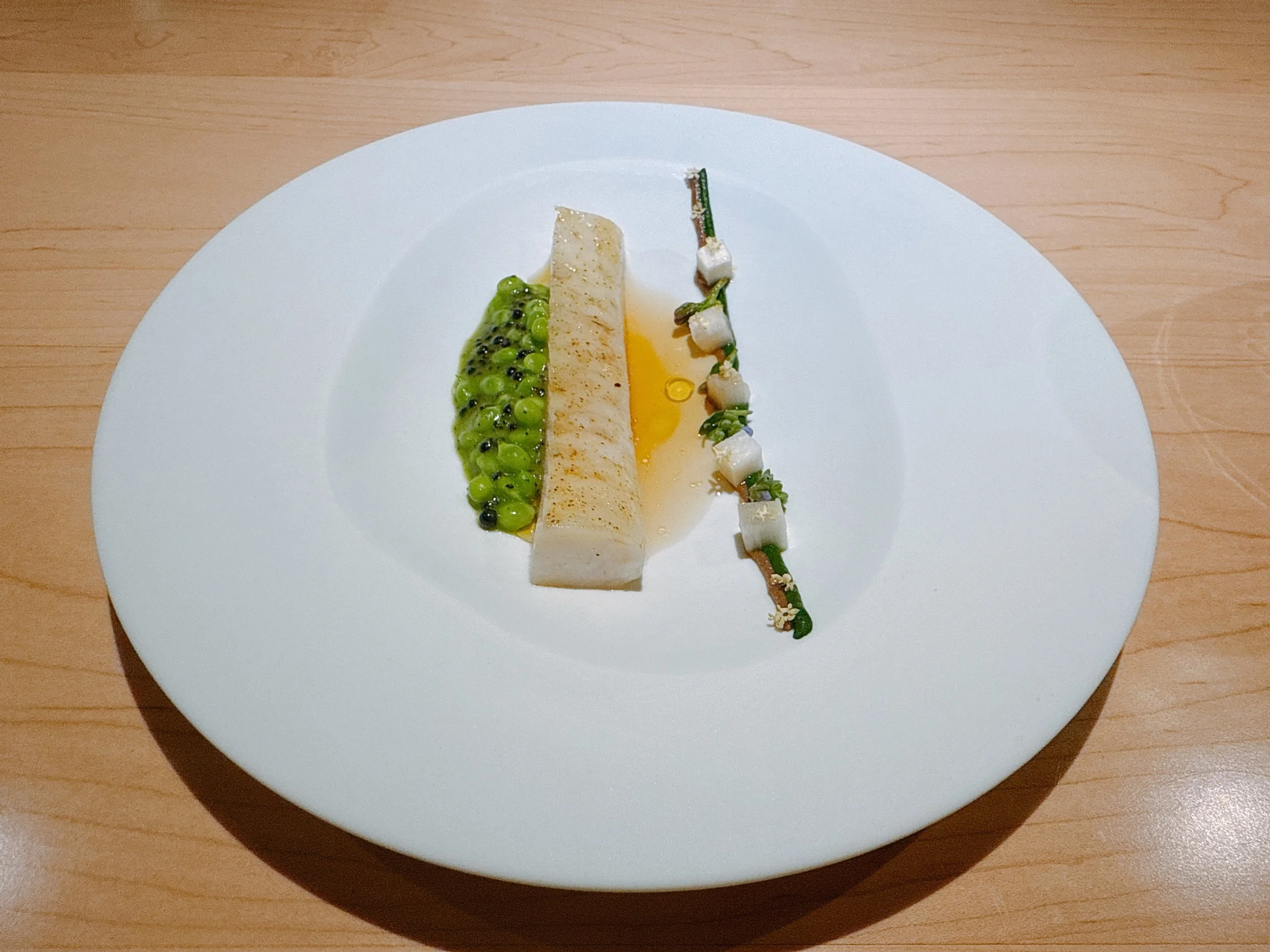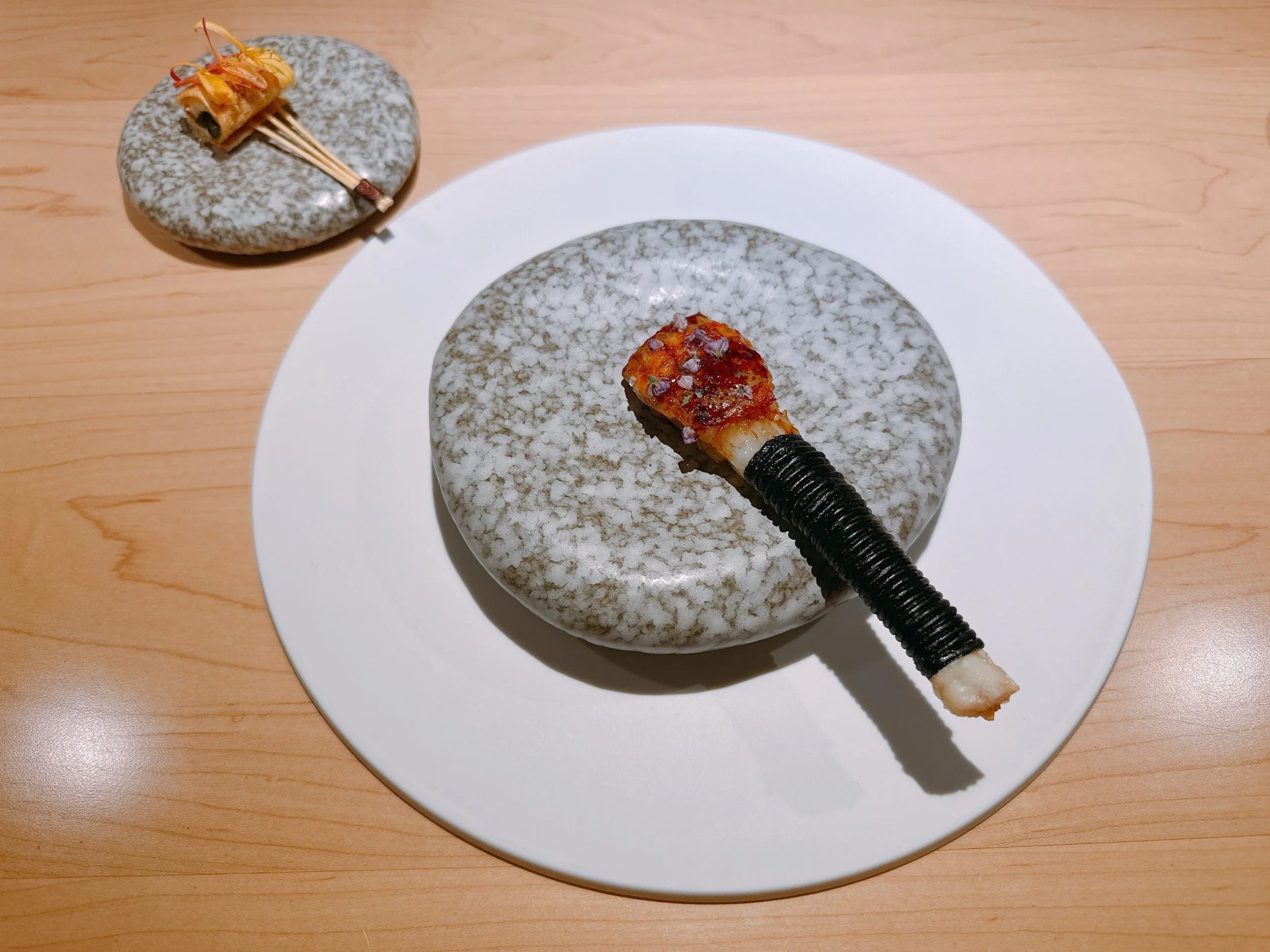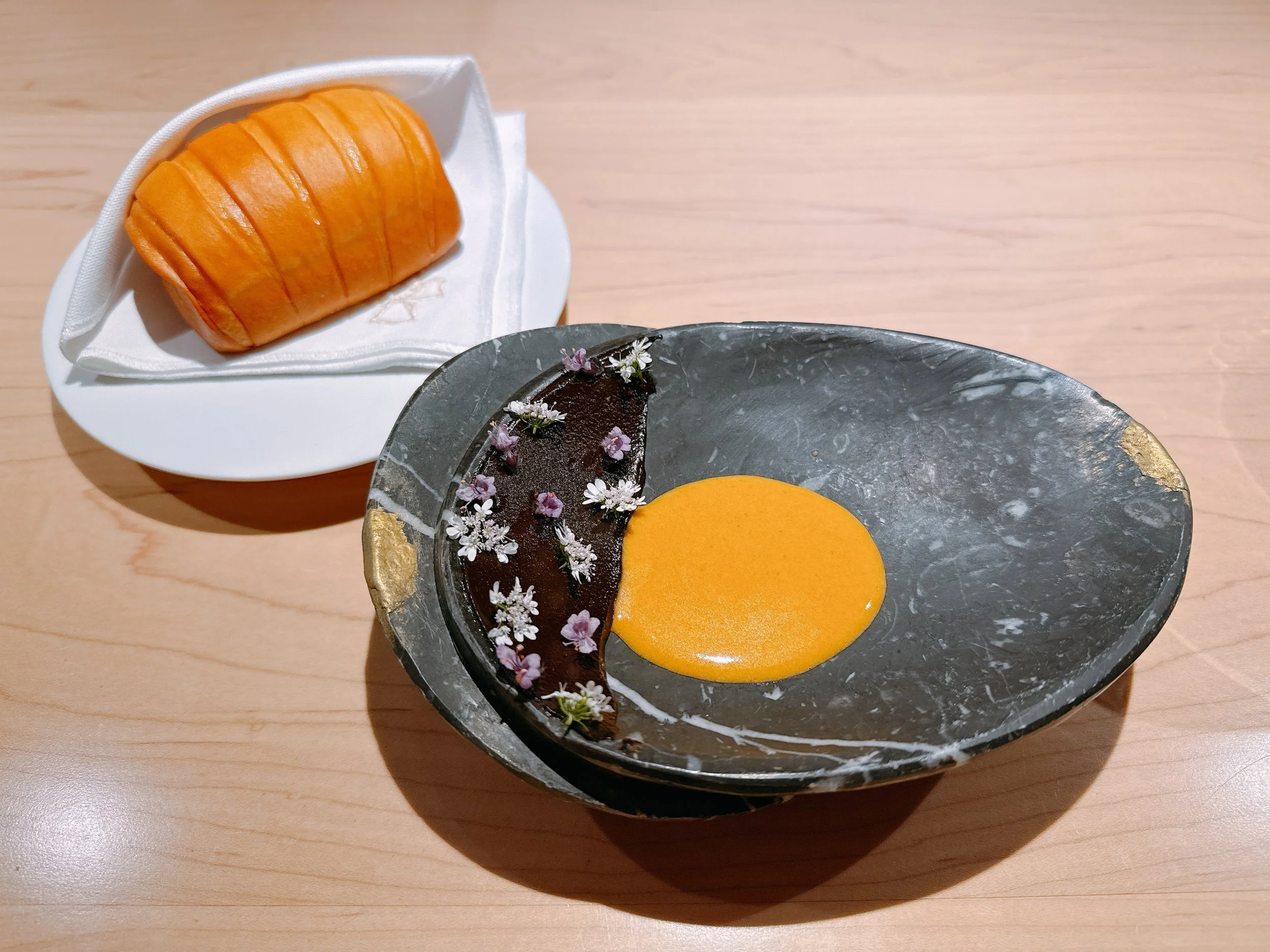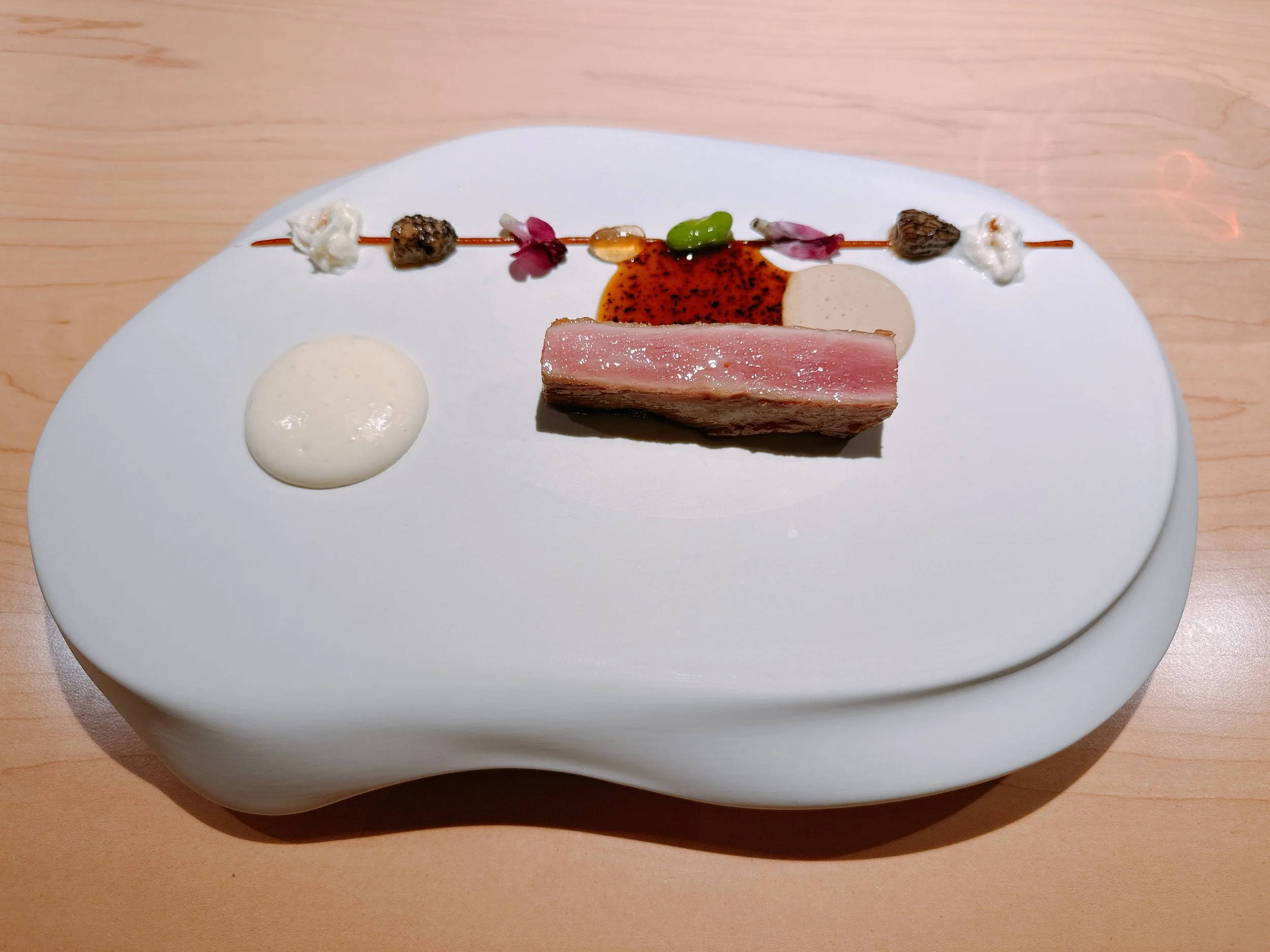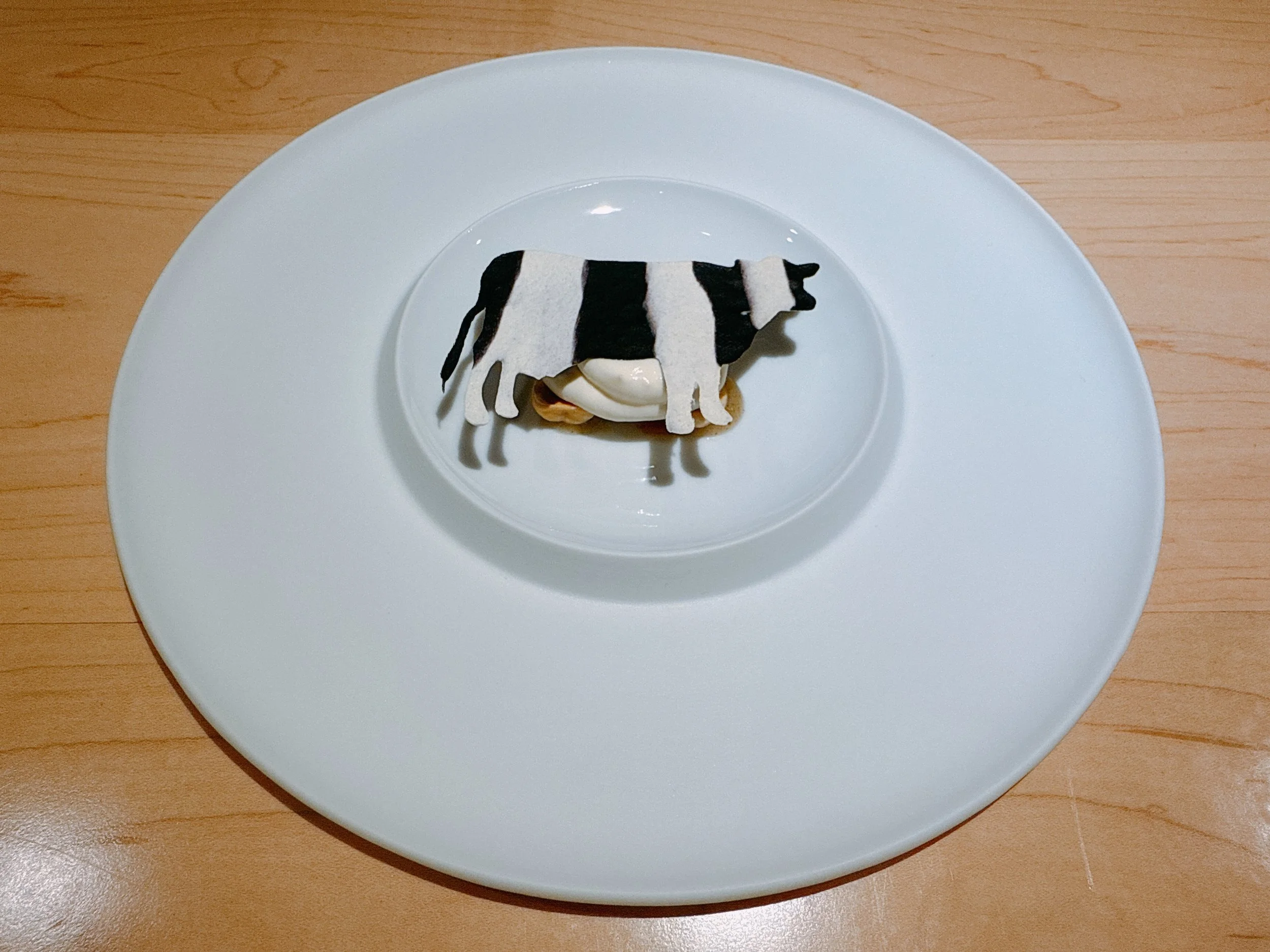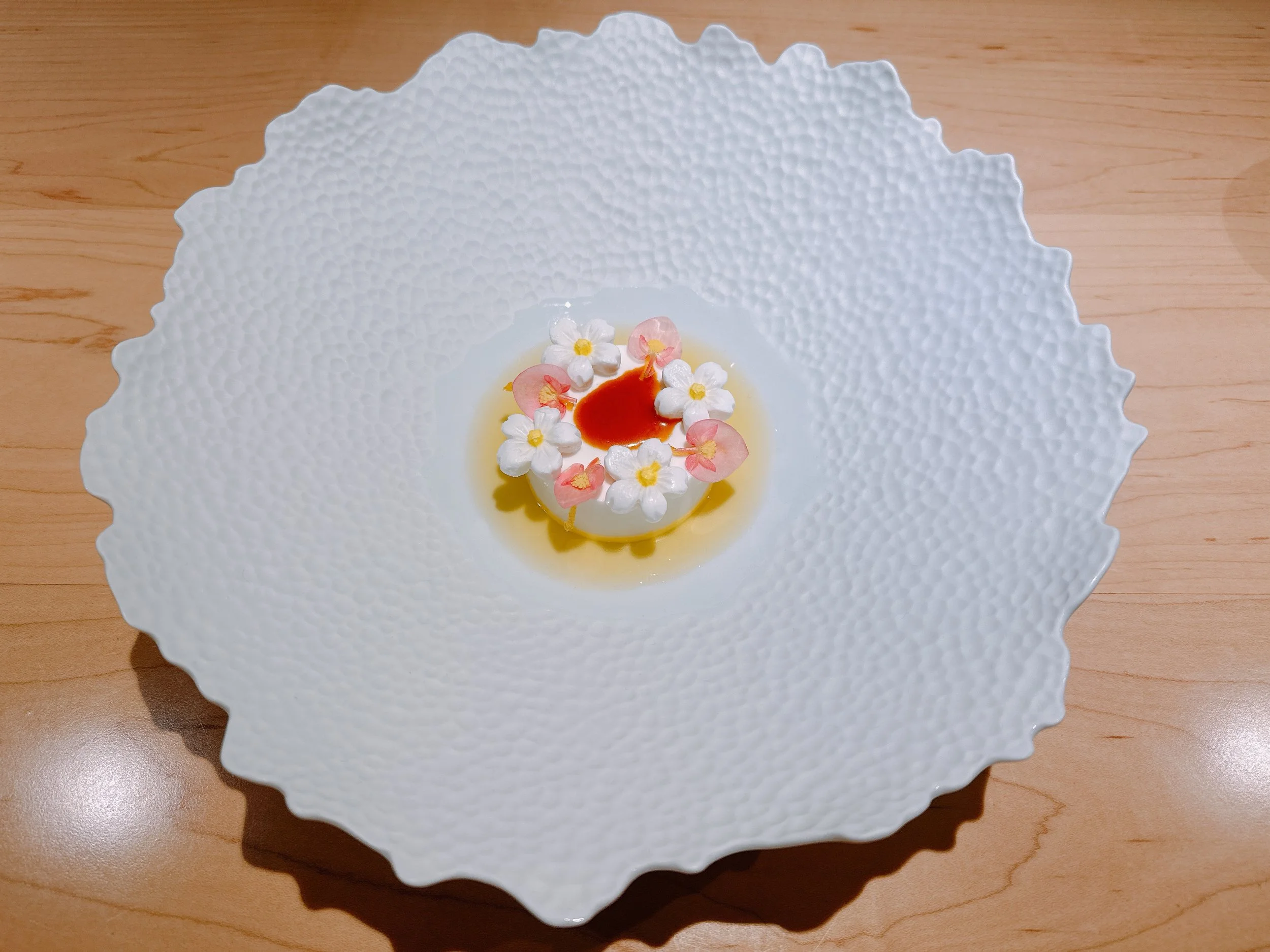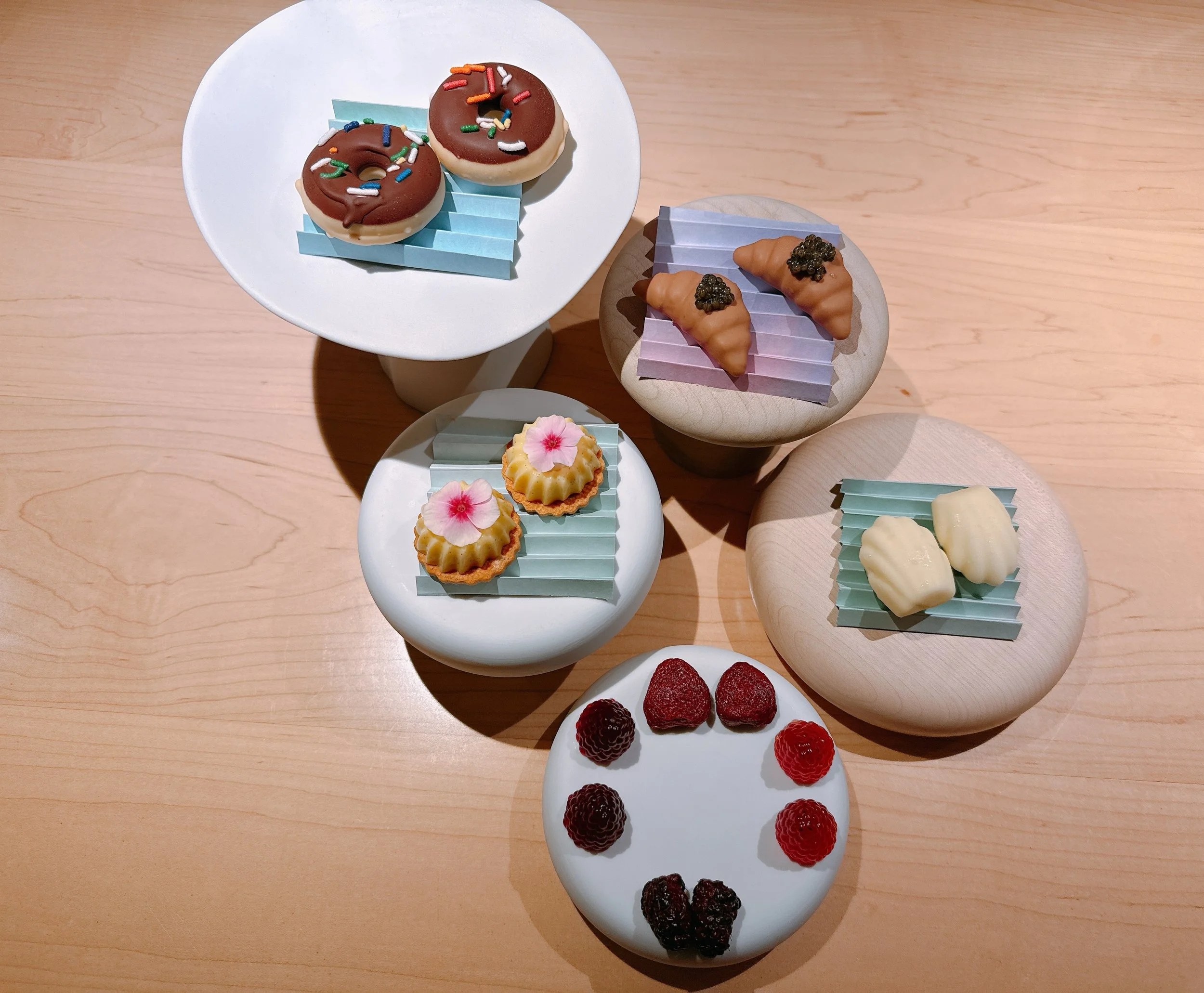Somni - West Hollywood
Rating: 18/20
Where: Los Angeles, CA
When: Dinner for 4 on 2 July 2025
Cost per Person: Tasting menu $495, Wine pairing $225-$1000
Accolades: 3 Michelin Stars
Why: Modern Spanish cuisine that looks like art; very interactive staff
“Somni” means “dream” in Catalan, and that’s already a hint as to what to expect at this restaurant on the border of West Hollywood and Beverly Hills. Chef Aitor Zabala indeed hails from Barcelona, and opened the original incarnation of Somni in a nearby hotel in 2018. The restaurant received two Michelin stars in 2019, but had to close less than a year later due to the Covid pandemic. It took a while to line up new investors and a new location, and “Somni 2.0” finally (re)opened in late 2024. Within only seven months, the restaurant managed to go straight to three Michelin stars, suggesting that they were probably close to the mark even before closing in 2020.
Somni's new location has a surprisingly rural, farmhouse feel to it - we didn’t seem to be in the middle of a city anymore. The meal started in a courtyard, whose surrounding buildings and decor were practically colored white. The majority of the dinner transpired indoors, though, in a dining room that had a similar farmhouse feel, with tall ceilings, almost church-like windows, a fourteen-seat wooden counter and a kitchen island that together took took up most of the floor space. There was only a single seating per night, and everyone was served at the same time, so it paid to be on time (not always easy given the unpredictable LA traffic). A separate private dining room had an earlier seating time.
Somni served a single, twenty course tasting menu, but - unusually for California - didn’t accommodate any dietary restrictions. But after seeing the amount of work that went into cooking and plating, that restriction became more understandable. Preparing different dishes for each guest might overwhelm a kitchen that already works from 7am-1am daily. Also unusually, guests were required to order a beverage pairing with the meal. These had to be chosen among three wine pairings, priced at $225, $415 and $1000, a mocktail pairing for $150 and a half mocktail/half wine pairing for $190. My dining companions reported that they liked the majority of their mocktails. At the recommendation of our sommelier, I went for the mid-priced wine pairing. Most of the wines were very good, generally consisting of bottles that would sell for several hundred dollars retail (see the list below). A bit better than the similarly-priced pairing that I had at Providence the previous night.
It’s worth mentioning the service at Somni, which was not only exceptional but also an integral part of the dining experience. During our visit, the staff members probably outnumbered the diners, and it showed. There was always someone nearby when we needed something, so that it didn't matter that there were no “assigned” servers for each party. For every course, different staff members stopped by our table and explained in detail what was in front of us. The difference between what's printed on the menu (very terse, see below) and what was conveyed during the dinner (very verbose) was extreme. A very high-touch experience.
As I mentioned earlier, our dinner started under the open sky in the restaurant's courtyard - a perfect setting on this warm summer's night. The fact that everyone had ordered a pairing meant that drinks started as soon as we sat down - no needs for aperitifs here, or for any decisions, really. (In a pinch, it's possible to change the pairing one is getting, though.) We were all served the first mocktail, called a “guisant-ito”, which was a play on a mojito made with peas, egg whites, and mint, garnished with pea tendrils. Much thicker than a real mojito, it also felt a bit flat taste-wise - some acidity might have helped (and made it more similar to a real mojito as well). Still, an interesting idea and maybe a 14 if I was rating drinks.
A total of six snacks were served outdoors, and they all arrived at the same time, slightly crowding our little table. First, we tried a beet/rose meringue sandwich filled with a blue cheese cream. The meringue was light and airy and a bit sticky. The filling added creaminess and some saltiness 17. Japanese iwashi (a kind of sardine) was served with a sofrito sauce on a little fish-shaped cracker. The fish was sliced very finely, causing it to melt in one's mouth. Even though the fish was quite fatty, this was a pretty light bite with a pleasant, slightly fishy flavor 17.
A fake mussel was served in a real mussel's shell - we were warned not to eat that outer shell. The fake mussel came in a cracker colored with squid ink. The filling included nasturtium, mussels and elderflowers. Another light dish, and one that had more of an herbal rather than a seafood flavor 17. Our next bite was made from Parmesan cheese and shaped like a white feather. This dish was again light (as a feather, I suppose...), with a nice cheesy and lemony taste 18.
An almond-shaped praline was made from almonds and filled with a lemon confit. It had a crunchy, sugary shell, and tasted mostly of lemons, and hardly of almonds. This was my least favorite among the amuse bouches - I thought that it was a bit too plain -, but the favorite of one of my dining companions. That's probably a good thing: there was something for everybody 16. Finally, we tried a mushroom-shaped millefeuille made with multiple layers of potatoes, porcini and a black truffle cream. Very tasty, creamy and having a light mushroom flavor. The thin crackers had gone a bit soft though, making them only slightly crunchy 17.
The common theme among all these appetizers was that they were light, very delicate, and had very intricate presentations. On the other hand, the flavors were not very bold - elegant rather than jumping off the plate.
Continuing our dinner indoors, we were served a dish that looked like a slice of pizza. Its “dough” was actually clarified tomato water that had been emulsified, made into a meringue and then dried for 12 hours before getting lightly torched. There were plenty of toppings: tomatoes, burrata, some thin slices of ham, oregano, basil and caviar. This dish might be considered a remote relative of a “pan con tomate”, a popular Catalan tapa, which would also explain its placement at the beginning of the meal. Fittingly, the first taste impression was a pungent tomato flavor, with the others ingredients, such as cheese, basil, and caviar layered in. The dough was airy and lightly chewy. I found this dish a bit hard to rate: if I closed my eyes and purely went by taste, then a 17 might have been appropriate. But the clever and beautiful execution practically begged for another point or two 18.
The next course was based on two Spanish soups: gazpacho and ajo blanco. Arguably, the contents of the bowl didn't really look like either, but all of the required ingredients were there. Peeled tomatoes had been marinated in vinegar and a fermented fish sauce. There were almonds, garlic, bread, little cubes of smoked eel, lemongrass and olive oil. The tomatoes practically burst with an intense tomato flavor, or more precisely, a gazpacho flavor. The rest of the dish created a counterpoint to the acidic tomatoes: creaminess, smokiness and a bit of crunchy texture (from the almonds). Lovely - in this case, the flavors outdid the presentation 18.
A dish featuring Dungeness crab followed. The crab meat had been mixed with finger limes and pomelo, and was seasoned with a bit of espelette pepper. Tableside, it was topped with a foam made from the crab's head, coconuts and ras el hanout spice. Next to the crab was a kohlrabi cream topped with flowers, herbs and ginger oil. The first taste impression here was sourness - the finger limes and pomelo were unmistakeable. Texturewise, they were also a good match for the strands of crab meat. The best way to approach this dish, though, was to eat everything together. The creaminess of the kohlrabi was vaguely reminiscent of crab butter, and it balanced the crab's acidity nicely. A great combination 18.
The staff described the next dish as “surf and turf”, but it was really more about the former than the latter. What looked like simply a mountain of caviar was actually just the top layer of the dish: underneath were a chutoro tuna tartare and bone marrow. A roasted chicken escabeche sauce was drizzled over the caviar. Next to this preparation sat a cauliflower chip topped with a dollop of cauliflower cream. The caviar was lovely, the chutoro had some unexpected crunchy ingredients, and the cauliflower chip added some texture as well. Overall though, the flavors in this dish tended towards the delicate end of the spectrum. Flavorwise, maybe more of a 17, but the presentation was awfully pretty 18.
Countless flowers adorned the following dish and the borage flowers on top were actually edible. They covered a beef tenderloin tartare sitting on top of a shiso tempura. The shiso tempura turned out to be a (hollow) ball of tempura batter with a single shiso leaf at its center. The trick behind this preparation was the addition of vodka to the tempura batter. The alcohol quickly evaporated during the deep frying process, causing the batter to puff up. Impressive - I imagine if I tried this at home, second-degree burns would be a more likely result. To be honest though, this dish was mostly about the beef tartare, which was well seasoned and cut to just the right size - flavorful and delicious. The tempura didn't really taste of shiso, but its crunch was a good textural addition to the beef 18. I was again tempted to round the rating up to 19 for the technique and presentation alone.
The following dish was also about something that was initially invisible: amaebi aka sweet shrimp. They sat at the bottom of a bowl filled with a celery root puree, trout roe, kombu, a corn sabayon and brown butter. A star shaped ravioli filled with huitlacoche was placed on top of the dish, and a blue corn bread came on the side. But back to the shrimp: they were indeed excellent, very sweet and with a creamy consistency. The popping trout roe was a nice textural complement. I'm always hesitant when corn features so prominently in a savory dish - the result is often too sweet for my taste. Here, though, that was not a problem: the corn sabayon was creamy, but not very sweet. The blue corn bread also felt like a “regular” bread: very crunchy, salty and a bit oily - the opposite of the mealy consistency and sweetness often seen with cornbread. The only weak point of this dish was the ravioli: quite soft (maybe overcooked?), with barely any flavor. It was more decoration than anything. But with a dish this good, that was only a passing concern 18.
The next two courses featured different parts of Spanish turbot, using almost the entire fish in the process. First, a filet of turbot that had been dry aged for five days and seasoned with smoked salt. Next to it were two purees, one made with blood sausage, the other with parsley, and both topped with cubes of white asparagus. On the other side of the fish were some teardrop peas mixed with butter, squid ink caviar and black truffles. Finally, there was a broth made from the bone and skin of the turbot, seasoned with mint. For me, the peas and the truffles were the highlight of the dish, with a great texture and lots of flavor. The fish was cooked to a firm texture, but had only a light flavor, mostly from some spices, and was much cooler than the peas, maybe a side effect of the plating process. The purees also had relatively light flavors 17. (Again, I was tempted to give an 18 for the pretty presentation.)
The second turbot dish featured the fish's fin and skin. The fin had been glazed with a teriyaki sauce, smoked and seasoned with shiso and lime. The skin was prepared as chicharrón: dried, fried, and filled with a yuzu butter and Californian seaweed. Starting with the fin: it had to be eaten by sucking the meat from the fin bones. The result was both meaty and gelatinous, fishy, nicely seasoned and overall very tasty (18 for this part). The skin was unfortunately not very crunchy, and instead pretty soft and chewy. The foamy yuzu filling was nice enough, but this was the weaker half of the dish (generously, 16). Overall 17.
Just before the last savory dish, we were served a bread course. A steamed and deep-fried brioche was filled with an oxtail curry. It came with a spicy peanut sauce and a generous helping of black garlic, presented as the black mirror image of the white kohlrabi from the crab course. The brioche had an airy texture, and the oxtail was juicy but only lightly flavored. The black garlic provided umami and a light sweetness, but most of the dish's flavor came from the surprisingly spicy peanut sauce - its spiciness lingered for a long time. Overall, this felt more like a “regular” course that happened to have bread in it, rather than a typical bread course. Not a complaint by any means, though 17.
Our final savory course featured Iberico pork, in particular its “secreto”, a particularly rich and marbled cut. The chef noted that Iberico pork was the true native wild pig of Europe, whereas most pork these days (even in Europe) was descendant from Chinese pigs. Also on the plate: a roncal cheese foam (meant as a substitute for Maldon salt), a jus made from pork ribs, a cream of morels, and a string of little bites including fava beans and morels. The latter were a mixed success: some were flavorful, but others didn’t seem to taste of anything, such as a bite with the texture of tofu skin. But the star of the show was the pork. Quite flavorful, with a hint of acorns, it went great with the sauces. The meat was a bit chewy but not overly so. Nitpick: I'd probably have preferred actual Maldon salt to bring out the pork flavor, without adding the cheese flavor of the roncal foam 18.
The cheese course contained not just cheese, but also hazelnuts, apples and vanilla. A lovely combination of a creamy, salty cheese with crunchy hazelnuts, a hazelnutty cream and fresh fruit 18.
The main dessert was a take on a pina colada in the sense that it contained both coconuts and pineapples: a coconut mousse, coconut sorbet, pineapple-lemon confit, caramel, and a sauce made from fermented pineapple skins, cinnamon, cloves, aniseed, pineapple juice and rum. Pineapples and coconut were clearly identifiable in this dish. Tasty, but a bit light on flavors - a bit more oomph might have made this even better 17.
Our dinner concluded with a collection of petit fours, most of them looking like bakery items, while actually being cream-filled pralines. First, we tried some berries (strawberries and blackberries) along with gummies made from the same fruits. I liked the strawberry jelly in particular, for its notable fruit flavor 17. Vanilla “madeleines” were really white chocolate pralines filled with a light mousse 17. Custard tartlets had a crunchy bottom and an eggy custardy filling 16. A chocolate “croissant” was a praline filled with dark chocolate mousse and topped with caviar and black truffles. Not very sweet 16. Finally, a rainbow sprinkled donut was filled with a vanilla mousse 16.
One thing that struck me about Somni was how it used modern culinary techniques. The fact that they were used at all was not really unexpected for a chef who had previously worked at El Bulli. But more surprisingly, the techinques never called attention to themselves, and dishes were primarily just meant to taste good. Quite unlike the many “showy” technique-driven restaurants in the fine-dining space - I appreciated the difference.
Overall: A great dinner in a relaxed setting, with an omnipresent staff always ready to discuss all aspects of the food and its presentation. Said presentation was uniformly beautiful, even by three-Michelin-star standards - this was some seriously impressive plating. Everything was also cooked expertly and tasted great. My main nitpick would be that the flavors sometimes felt too restrained. Maybe that was meant to match the elegant presentations, but I would have preferred a bit more oomph. Nevertheless, a very distinctive experience 18.
